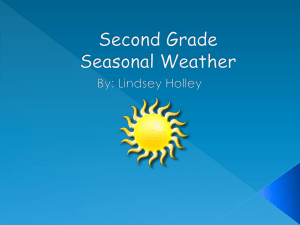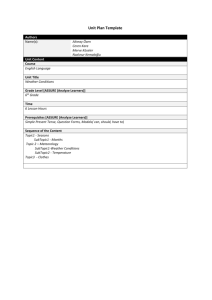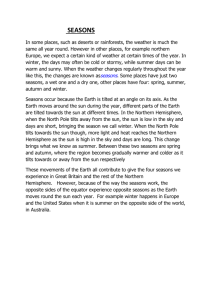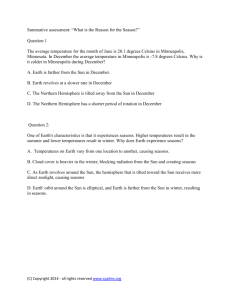Seasons - Aurora Public Schools
advertisement
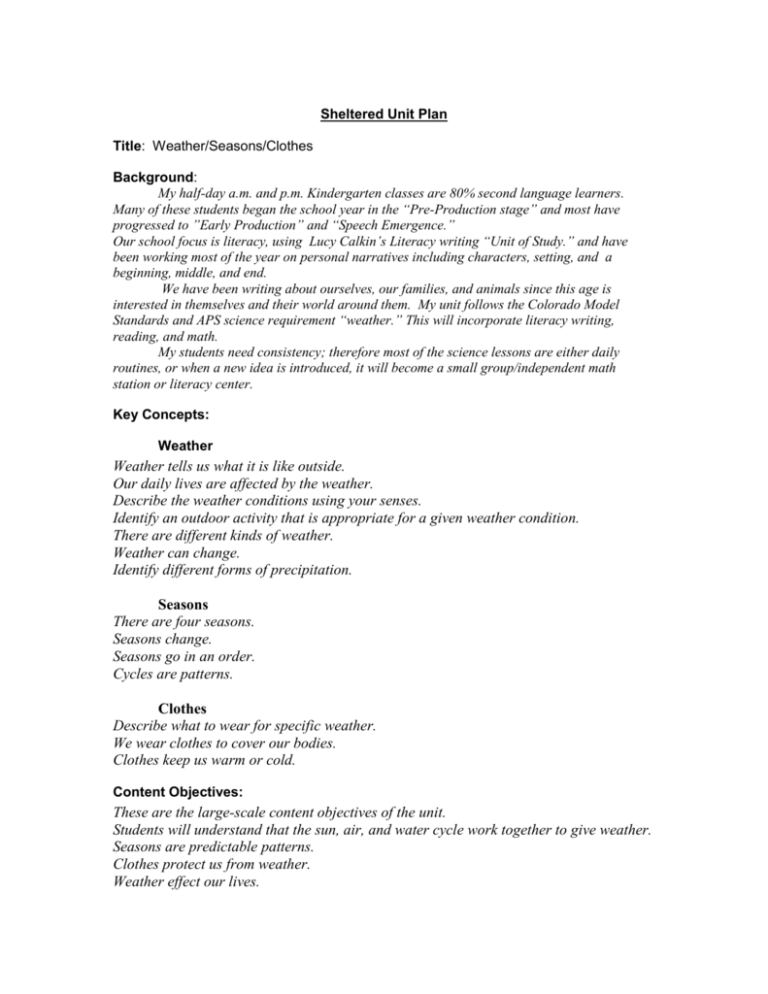
Sheltered Unit Plan Title: Weather/Seasons/Clothes Background: My half-day a.m. and p.m. Kindergarten classes are 80% second language learners. Many of these students began the school year in the “Pre-Production stage” and most have progressed to ”Early Production” and “Speech Emergence.” Our school focus is literacy, using Lucy Calkin’s Literacy writing “Unit of Study.” and have been working most of the year on personal narratives including characters, setting, and a beginning, middle, and end. We have been writing about ourselves, our families, and animals since this age is interested in themselves and their world around them. My unit follows the Colorado Model Standards and APS science requirement “weather.” This will incorporate literacy writing, reading, and math. My students need consistency; therefore most of the science lessons are either daily routines, or when a new idea is introduced, it will become a small group/independent math station or literacy center. Key Concepts: Weather Weather tells us what it is like outside. Our daily lives are affected by the weather. Describe the weather conditions using your senses. Identify an outdoor activity that is appropriate for a given weather condition. There are different kinds of weather. Weather can change. Identify different forms of precipitation. Seasons There are four seasons. Seasons change. Seasons go in an order. Cycles are patterns. Clothes Describe what to wear for specific weather. We wear clothes to cover our bodies. Clothes keep us warm or cold. Content Objectives: These are the large-scale content objectives of the unit. Students will understand that the sun, air, and water cycle work together to give weather. Seasons are predictable patterns. Clothes protect us from weather. Weather effect our lives. Language Objectives: o Speaking: Describe the weather. Explain what to wear. Key Vocabulary: Sunny Windy Cloudy Snowy Rainy Foggy Hot warm cold condensation, precipitation, evaporation Language objective: *Students will be immersed in proper English language structure throughout the day. *Students will approximate proper written English in daily draft books. *Students are expected to respond to teacher/peers in groups discussion. *Students will approximate oral questioning techniques to peers after published books are read to whole class. Students will ask questions related to the world around them. Language structure: What is the weather like today? What can I do today? What should I wear? Today it is (sunny). It is (sunny) outside. Today’s weather is… I can _______ in the summer, fall, winter, spring. Spring – flowers blossom, leaves grow and turn green, grass is green, rain, warmer outside, and days are longer. Summer – it is hot, long days, short nights. Autumn/fall – leaves turn color and fall down, cooler outside, rains, days are shorter. Winter – trees have no leaves, snows, cold, short days, long nights. Language structure: It (snows) in the (winter.) It is (winter.) Connect to weather Clothes: Language structure: When it’s _____ I wear ___________. I am wearing a (shirt.) I have a (shirt.) Listening: Watch and listen to teacher demonstrations. Listen to books read aloud. Reading: Read content books in small guided reading groups Read own published books from drafted stories with given content prompts. Writing: Daily writing in draft books (from content prompt) Daily writing in draft books relating to content following teacher’s demonstration. Whole class/small group shared writing books. Learning Strategies: KWL charts Venn Diagrams Concept mapping Picture graphs for math information Cooperative learning groups Assessment: Oral language, draft books, observation during group discussions, observation within small groups, math stations, and literacy centers. Daily Lessons: UNIT: Weather (INTRODUCTION TO UNIT) Lesson: Time Frame Sharing what we know and want to 1- 20 minute lesson know about the weather. Key Concept: Weather tells us what it is like outside. Content Objective: KWL chart – Students will make statements about what they know about weather. Students will ask inquiring questions about what they want to know about the weather. Language Objective: Speaking and listening: Students will share with partner, and volunteer in whole class questions they have. Students will learn how to make statement and how to form a question. Language Structure: Type of Grouping: I know that _______________. Whole class I wonder _________________. Assigned pairs for sharing Key Vocabulary: What When Where How Why This vocabulary will be posted on wall with icons to be used daily as prompts for questioning. Activate Prior Knowledge What do you know about weather? Differentiation: Lau A will share with proficient English speaker, English speaker will share whole class. Materials: Chart paper, Markers of different colors for each student’s response. Daily draft books Box of weather (science) books Description of Lesson Whole class: I will ask all what they know about the weather. I want them to share something they know with an (assigned) partner. Quiet thumbs up when the pair has a response. I will record all the responses in different colors on chart paper so students will recognize which comment is theirs. Then, they need to share with their partner a question they have about weather. This will be framed within the language structure using the key vocabulary words for questioning. Independent work: They may choose to “read” picture books about weather; They may choose to write about this subject in their draft books. Review/Assessment: We re-read the chart paper. Students will recognize which comments are theirs. During literacy centers, one box of weather (science) books will be available for inquiry. I will monitor who uses these and if they are looking at pictures to get some of their answers. I will be monitoring daily writing in draft books to see who is showing interest and writes about this subject. Home-School Connection: Letter going home explaining our new weather unit and asking families to talk with their child about weather conditions. UNIT: Your (4) senses Lesson: How your (4) senses may describe the weather – making you aware of your environment Key Concept: Weather conditions may be determined using your senses. Time Frame 1 lesson – 30 minutes Content Objective: (Review) five senses. Describe the weather using: Sight, hearing, smell, and touch (leave taste out) Language Objective: Seeing: Bright, light, sky blue, white clouds, blowing trees, plants waving Hearing: Birds, wind, breeze blowing Smelling: Air, rain, plants Touching: Feel wind, trees, leaves, feel the heat and cold. Language Structure: Type of Grouping: Today I feel _________. Whole class sit in circle. Half will step Today I smell _______. forward to form an inner circle and the rest Today I see _________. will stay in an outer circle. Today I hear ________. Inner circle will turn around to face a partner. Whole class Key Vocabulary: See, hear, feel, smell Activate Prior Knowledge: If it is (snowing, sunny, rainy, etc.) outside… what can you smell? what do you see? what do you hear? what can you touch? Differentiation: The outer circle are Intermediate to Advanced English fluency, and native English speakers. The inner circle are Silent and Receptive Stages – Early Production,-Speech emergence. Some pairs may draw more than one of the senses they saw, heard, felt, smelled outside. Materials: Large chart with 4 Senses icons. Clip board, paper, pencils Paper for each pair of inner circle and outer circle. Crayons Description of Lesson We will walk outside our classroom with pencil, clip board and paper. (whole class) Come back in classroom. All sit in circle – I call names of (Silent and Receptive and Early Production) students. They will take one step in circle and sit down facing the outer circle (Students of Speech Emergence, Intermediate Fluency, Advanced Fluency – all English speakers.) This will form a partnership of pairs at different English speaking levels. The pairs will choose one of the 4 senses and draw a picture with another paper and crayons of what they saw, heard, felt, and smelled when we were outside. All come together in whole class and post the paired paper drawings on a big chart under appropriate sense. Review/Assessment: We re-visit the chart daily to help determine how and why our senses help us describe the daily weather. Home-School Connection: Letter home to families explaining how our senses help us describe changes in weather. Have their child chart weather by using their senses before coming to school. UNIT: Weather graph Lesson: Record daily weather using weather symbols. Key Concept: Compare Weather can change – weather tells us what it is like outside. Time Frame Daily – 10 minutes Content Objective: Students observe and record today’s weather. Students organize information on class graph – pocket chart with picture icons labeling “sunny, cloudy, rainy, snowy, windy, cold, hot.” Language Objective: Sunny, cloudy, rainy, snowy, windy, hot, cold. Language Structure: Type of Grouping: ______ is the most days. One student is chosen to be weather person each day. ______ is the least days. ______ are the same or equal. More than, less than, same or equal. Pair student on floor to think-pair-share which weather has the most, least, same or equal. This on-going language structure will be posted on wall and used in other comparing situations. Key Vocabulary: Sunny Cloudy Rainy Snowy Windy Hot Cold Activate Prior Knowledge: Differentiation: How was the weather when you came to school today? Did you wear a coat, hat, mittens, boots, etc. Was the sun shinning? Turn to your partner and tell them what you think the weather is like today. (May look out the window.) Materials: Large pocket-weather graph chart with icon symbols on bottom row of graph. Individual icon pictures with matching pictures/words to be placed from bottom-up daily in appropriate spaces on pocket chart. Description of Lesson I choose a weather person by picking a stick with their name on it every day. This is a fair choice – they all know the will get a turn another day. We sing “What’s the weather like today, like today, like today, What’s the weather like today, in 2007?” The weather person record with a weather symbol on the chart. We they discuss as whole class which weather has been the most, least, or same/equal. Review/Assessment: We re-visit the weather chart every day and count how many of certain weather days we have had. Periodically I will individually ask students to point out the “Most, least, or same.” Students usually come into classroom excited to tell me about the weather they see on the way to school. I require a full sentence. Home-School Connection: Have student discuss daily how the weather is with family so they will be prepared to be the accurate weather person. UNIT: Seasons Lesson: Introduce four seasons Key Concept: Recognize the differences between the seasons. Time Frame On-going Content Objective: Name seasons and their characteristics Language Objective: Asking questions about weather in different seasons Language Structure: Type of Grouping: What to we do when it (snows) in the Whole class, small groups (winter)? Key Vocabulary: Winter Spring Summer Autumn (fall) Swim, sled, make snowman, make snowballs, fly a kite, ride a bike, etc. Activate Prior Knowledge: Differentiation: What do you play/see outside in the winter/summer? Individuals work on paper plate activity Materials: Paper plate per student, crayons Description of Lesson I will demonstrate whole class how the earth circles the sun once each year. The sun is the source of light and energy. We will do a shared writing about symbols and our favorite things about each season on chart paper. They will make the four seasons on a paper plate drawn with lines to divide it into quarters. They will label each quarter and illustrate each season (what ever symbol they like about the season.) Review/Assessment: Share with whole class finished paper plates. Home-School Connection: One day each season, whole class stand outside (dressed for weather) by a tree on school grounds. Teacher will take a picture and will send home to each student these four pictures made into a season book (showing what we wear and how the tree changes.) Send home letter to families to discuss with their child different activities they have done as a family in summer and winter. (Including holiday celebrations.) UNIT: Activities/clothes appropriate for seasons Lesson: Time Frame Charting on Venn Diagram activities 1 20 minute lesson and and clothes appropriate for seasons. made into a daily choice center Key Concept: Content Objective: Recognize how our daily activities are affected by the weather. Describe what to wear for specific weather. Identify an outdoor activity that is appropriate for given weather condition. Language Objective: Speaking and listening: Students will question what activity/clothing is appropriate. Language Structure: Type of Grouping: I wear a (jacket) in the (winter.) Whole class I like to (sled) in the (winter.) Small groups Key Vocabulary: Jacket Mittens/gloves hat boots swim suit t-shirt shorts sled ski snowboard swim bike Activate Prior Knowledge: Differentiation: What do you like to do in the winter/summer with your family? What do you need to wear to do this? Whole class “concept map” will promote interest and language of clothes and favorite activities for all students before small group work. May have some students come to school with an illustrated list from home with family activities or celebrations they do during certain seasons. Others may approximate writing and illustrating what they like to do. Materials: Easel/chart paper/marker Yarn Clothes from Goodwill Pictures of activities and sports Description of Lesson Whole class: make a shared concept map of seasons/weather and clothes/favorite activities appropriate for conditions In small groups, yarn will form two overlapping circles on the floor to represent hot (summer) and cold (winter.) They will place clothing and/or pictures of activities in correct circle. Some may overlap and be placed in the center. We will come together and each group will present their Venn Diagram. Whole class shared writing about their discoveries in a list form (t-graph) Review/Assessment: We re-read the t-graph and review why certain clothes and activities are appropriate for certain seasons. Home-School Connection: Take picture of groups standing by Venn Diagram and pictures will go home to promote conversation. UNIT: The Water Cycle Lesson: Show where precipitation comes from Key Concept: Where water comes from. All water is part of water cycle. Time Frame 1- 30 minute lesson Content Objective: The sun warms water from lakes, oceans, etc. which makes some evaporate into a cloud. The cloud becomes saturated, preciptation falls and cycle repeats. Language Objective: Asking questions about where rain/snow comes from. Asking questions about where clouds come from. Language Structure: Type of Grouping: Rain/snow is precipitation. Whole class, small groups, independent Some rain/snow falls into oceans, rivers, lakes and some soak into the ground. Sun warms water into evaporation. Key Vocabulary: Evaporation Condensation Precipitation Activate Prior Knowledge: Differentiation: Where does the water come from that you drink? Where do you think it comes from before your sink? Have you ever looked up in the sky and watched clouds? Think, pair, share with assigned partners. Materials: Chart paper on easel, marker Sponge, water Water cycle color sheet: Water cycle game (kinetic game activity) Computer water cycle game Description of Lesson I will ask questions about what they know where water comes from. Read a book about rain, water, animals, and plants. (all need water.) Whole class: draw a large water cycle on chart paper. We all stand up - recite and do hand and arm motions to “condensation” “precipitation” “evaporation.” I show them a sponge, tell them it is like a puffy cloud, then I “saturate” the sponge until it can’t hold anymore water. I sprinkle water on whole class. Explain what happened – lake water evaporated into a cloud, the cloud became very heavy, and then it rained. By the time I finish explaining – I ask who is still wet?– they have dried (evaporation.) inquiry – what happened to the water? They will label and color the water cycle on “Water Cycle” game work sheet. Play game with small group of 3-4. Use giant die. All start in river. Roll die, move that many squares up to cloud, then down to ground and river – put on water droplet necklace. The first player to circle the water cycle three times (has on three water droplet necklaces) wins. Independent activity during literacy activities: www.southeastwater.com/au/games/education_kidsroom_wcactivity.asp Review/Assessment: Next day, ask where rain comes from. Water cycle game becomes math station. Home-School Connection: They take home their water cycle sheet they colored – they are to tell families what this is using the new vocabulary. UNIT: Clouds Lesson: Observe clouds Classify Stratus, cumulus, and cirrus Key Content Concept: Objective: Clouds Three are types of collectionsclouds: of water Stratus, droplets. cumulus, There are and three cirrus. main types of clouds. La ng ua ge Ob jec tiv e: As kin g qu esti ons ab out wh Time Frame 2- 20 minute lessons (two days) ere rai n/s no w co me s fro m. As kin g qu esti ons ab out wh ere clo ud s co me fro m. Language Structure: Today the clouds are _______ and are called _____________. Type of Grouping: Whole class, small groups Key Vocabulary: Stratus Cumulus Cirrus Activate Prior Knowledge: Differentiation: Have you ever looked up in the sky and watched clouds? What shapes have you seen? Materials: Copy of cloud classification chart Set of 9 cloud photographs for each group The number on the back of each pictures identifies the cloud classification. Photos number 2, 6 and 9 are stratus; 3, 4, and 7 are cumulus; 1, 5, and 8 are cirrus clouds. Large blue construction paper for each group folded in thirds. Cotton balls Each member of group will glue cotton balls on top of third to resemble cloud (some may be Think, pair, share with assigned partners. stretched) Description of Lesson Class divided into groups of 3 Each member colors his/her own cloud classification chart with labeled clouds. Group folds their blue construction paper into thirds; each member decorates 1/3 into their cloud classification. Group members help each other to place cloud photographs onto correct cloud formation third of blue paper. They will glue photos down and present to class. This will be displayed in classroom. Review/Assessment: Write in draft book what weather may be like and what activity they may do by observing certain clouds in sky. Home-School Connection: Send home letter to families about what we have learned about clouds. Send home blank chart so student and family may chart daily clouds for one week. UNIT: Revisit KWL chart (Conclusion) Lesson: List facts we have learned within this unit. Have we answered our questions? Time Frame 1- 20 minute lesson Content Key Concept:Objective: Review Realizing our amount of new questions information we – what have learned have we about learned? weather/seasons. La ng ua ge Ob jec tiv e: Sta te me nts are ans we rs fro m qu esti ons . Language Structure: Statements are facts – not questions. Type of Grouping: Whole class Key Vocabulary: Now is know that _____________ because _________________. Activate Prior Knowledge: Differentiation: Re-read KWL chart Think, pair, share with assigned partners. Materials: KWL chart Easel Marker Description of Lesson Whole class comes together – we re-read facts we thought we knew about weather/seasons – may correct some wrong statements through our new knowledge. Re-read questions we had. Chart and answer questions under the “L” column through shared writing new information we have learned. Review/Assessment: Re-read the whole chart. In pairs – talk about another other questions they may have New chart – Where can we find information for newly developed questions? Home-School Connection: Take digital picture of both charts. Make copy for each student to take home. Send home letter explaining that even though we have learned so much about weather/seasons, there are still more unanswered question. Please take your child to the public library and look for appropriate books that may answer new questions.




